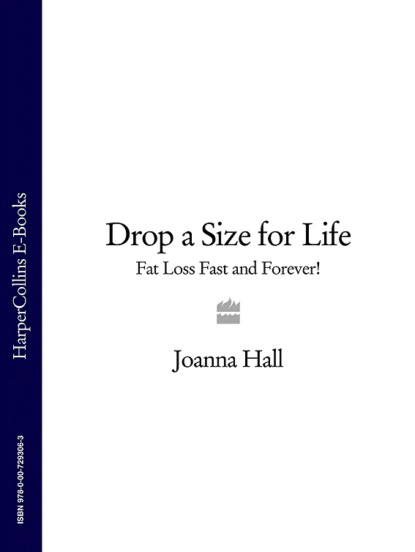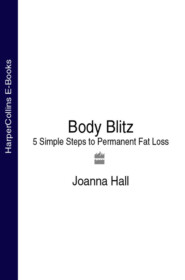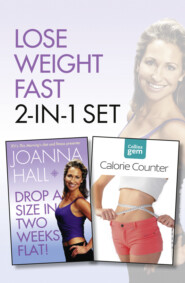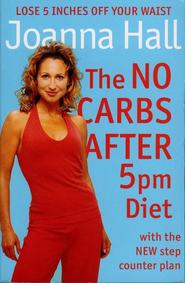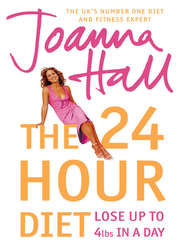По всем вопросам обращайтесь на: info@litportal.ru
(©) 2003-2024.
✖
Drop a Size for Life: Fat Loss Fast and Forever!
Настройки чтения
Размер шрифта
Высота строк
Поля
You know what 100 per cent full feels like, so back off before you reach that point. At first, eating until you’re about 80 per cent full may feel an alien thing to do – perhaps you were always told to finish everything on your plate as a child, or your body just really likes that feeling of being very full – but persevere with this, it has multiple benefits.
THE LOGIC
Your schedule may not allow you to always take as much time as you would like over each meal or snack, so learning to eat until you are 80 per cent full is a back-up plan that works hand-in-hand with taking more time over your food. This allows your brain to become aware of the food entering your body, which stops you from over-eating and actually energizes you more. Eating too much food decreases your immediate energy levels, as your body has to work harder through a process called the ‘thermic effect of feeding’ to digest your food. This can leave you devoid of energy and feeling as if you need to reach for that chocolate bar for an instant energy fix. In addition, you should start to feel empowered as you feel more in control of your food volume. Saying no can be very powerful.
ACTION POINT 3: EAT WITHOUT DISTRACTIONS
WHAT YOU NEED TO DO
Try to eat your meals without any distractions. In your lunch break, stop trying to finish off a report as you munch at a sandwich; at breakfast, avoid grabbing mouthfuls of toast in between applying your mascara and ironing your blouse for work. Okay, okay, I hear you say – where am I going to find the time to do this? Well, I do understand that you may not be able to do it for all your meals for the whole week, but do try to do it at least once for each meal during the course of your first week. Try to focus entirely on the food on your plate – look at the colours before you start to eat, feel the texture of the food in your mouth and chew your food completely before you swallow.
THE LOGIC
Today’s fast-paced lifestyles mean that eating meals gets put on the ‘to do’ list as we multi-task with other aspects of our busy day. However, eating should not be a task – it should be an enjoyable experience that you share with friends or take time over. Sadly, it has become so rushed that we no longer seem to appreciate what we are eating or the actual sensual pleasure eating can give us. Eating can be sexy! Taking the time to really concentrate on and relish your food will heighten your awareness and sensuality of food. Focus on both the amount you are eating and the way it feels as it enters your body.
ACTION POINT 4: BELT UP!
WHAT YOU NEED TO DO
Stop wearing elasticated waistbands. Replace them with fitted waistbands or belts. Do this straightaway, not tomorrow, not next week, but straightaway. You need a reference point that tells you how much space your body takes up and this will help your brain to become aware of this.
THE LOGIC
Elasticated waistbands lull you into a false sense of security. They encourage your abdominal muscles to become lazy, as there is no reference point for your tummy muscles to press against. Although it sounds rather insignificant, changing to inflexible waistbands is a very effective act. Firstly, by changing to a rigid belt you are able to mark your progress on your belt notches. Secondly, the act of changing to a rigid belt is a positive step towards getting to know your body better.
If your clothes only have elasticated waistbands, tie a thick piece of ribbon around your midriff under your clothes. Fix it firmly so you can feel it around your waist without it digging into you – this will give you a reference point of where your body ends and the belt begins. If you are a man, your task is to stop lowering your waistband so it lies under your beer belly. This only further lulls you into a false sense of security that your belly really isn’t that big. You don’t have to wear your trousers under your ribcage but you do need to start accepting the ‘real waist’ situation. And, as a bonus, doing this will improve your posture.
THE BOTTOM LINE
Like any relationship worth sustaining, the brain-body link needs attention and care in order to remain strong. Don’t become lazy in maintaining mind-body awareness. Once you have fostered a closer relationship between your brain and body, you are ready for step two.
Case Study: Rebecca’s Story
‘Although I was desperate to lose weight, all the diets I had read about involved cutting out all the foods that I enjoyed the most: chocolate, biscuits, pies, chips, lasagne, cheese, mayonnaise, quiche etc. To have to consider giving them all up was just too daunting. Then I read the Drop a Size plan. First of all I increased my water intake – that alone gave me energy. I didn’t feel so groggy all the time and was able to think more clearly. Within a couple of weeks my body began to ask for water – it had become automatic. I made up my mind that, while I would make healthier choices, if I needed a chocolate fix I would have one, but a small one. By Christmas I was close to being ready to start dieting. January 2nd was ‘D’ Day – Diet Day. But I didn’t go all out. I wanted to be kind to myself and ease myself into the process in a way considerate to my needs. I knew myself, and my limitations, and I wanted to succeed, so I made it challenging but not scary.
For the first couple of weeks of following the Carb Curfew I went to bed in the evening with a light feeling in my stomach that was alien to me. Before, my usual evening meal was meat, sometimes vegetables (not always) and potatoes or rice or pasta. I was so accustomed to feeling heavy, lethargic and sometimes bloated that I thought it was normal. The extra energy I had in the evenings gave me the motivation to exercise. It was all beginning to snowball and I was feeling really good. Only when I began to feel some of my clothes a little looser did I venture on to the scales. I had lost 4lbs. It was the incentive I needed to carry on.’
STEP TWO: (#u0ce09cbd-d8b0-596c-8d62-1a2010e4f3fa)
BEFRIEND THE MIRROR (#u0ce09cbd-d8b0-596c-8d62-1a2010e4f3fa)
As we cast a critical eye over our bodies in the mirror, many of us focus on one particular body part. When you stripped off and assessed yourself, did you find yourself honing straight in on your much-hated hips or tummy? If so, you probably felt pretty negative about yourself by the time you turned away from the mirror. That’s why it’s important to look beyond the mirror and acknowledge that your reflection is not all you are. Think about all the things your body can do, the pleasure it can provide, the miracles it has performed, the strength, endurance and power it has. Think how great it feels when you get massaged, or when you stretch after waking up or after a workout; how good it feels to slip into a hot bath, eat something delicious or dance. All these things are about your body and the way it feels, the way it performs, the way it can be challenged. Your body is so much more than that reflection you are so critical of.
Imagine seeing yourself through the eyes of one of your friends. How would you describe your body if you were to look at it as an outsider? Write that description down now, being as honest and accurate as you can be. The chances are if you’re looking at yourself through someone else’s eyes you’ll be a lot kinder, so use these more realistic judgements when you’re casting a critical eye over yourself and determining your goals and objectives. The reality is that everyone has good and bad points. Having a big bum, a beer belly or flabby upper arms doesn’t make you a bad person, a failure, or in any way a lesser being than the supermodels that pout at us from the pages of countless glossy magazines.
ACTION POINT 1: ACKNOWLEDGE THE POSITIVE
WHAT YOU NEED TO DO
Look at your reflection in the mirror and find one physical thing about yourself you like. It can be anything from the shape of your little toe, to the way your nose wrinkles when you smile, or the shape of your ankles. Whatever it is, find one thing and tell yourself out loud why you like it.
THE LOGIC
Acknowledging something you like about your body shifts the emphasis away from the bits you don’t like. By doing this you start to see your body as a whole rather than as a collection of isolated bits. This will help you feel more positive about your body and, because you feel better about it, you will use it in a more positive way.
ACTION POINT 2: BUILD UP YOUR GOOD POINTS
WHAT YOU NEED TO DO
As the days pass, find another aspect of your body you like and say it out loud, along with the bits you liked from previous days. For example, if on day one you said ‘I like my little toe’, then on day two repeat this out loud together with the next body bit that you like. Continue to add a new ‘like’ each day until you are repeating a lengthy list of aspects of your body that you like.
THE LOGIC
Reinforcement is a powerful tool in helping you believe in something.
ACTION POINT 3: MAKE IT YOURS!
WHAT YOU NEED TO DO
Think about precisely why you like each body bit and repeat these reasons out loud as you look in the mirror.
THE LOGIC
Personalizing why you like these good bits helps you develop a closer relationship with your body and encourages you to like your body for reasons beyond conventional beauty. This will help you challenge your thought process on what makes someone beautiful or acceptable. Quirkiness can actually be to your benefit, so learn to embrace all the parts of your body so you can make friends with what you see in the mirror instead of criticizing it.
ACTION POINT 4: PAY YOURSELF A GENUINE COMPLIMENT
WHAT YOU NEED TO DO
I want you to pay yourself a genuine compliment each morning as you look in the mirror. Choose a different compliment each day – it can relate to you physically or be about something you have accomplished in your life. Whatever it is, you need to say it out loud as you look at yourself in the mirror.
THE LOGIC
Seeing your reflection is about facing up to who you are physically, but it is also about acknowledging that there are many facets to the person you see in the mirror. Accepting and praising yourself for all your qualities helps you to accept yourself physically, mentally and spiritually. Being content with yourself is not just about whether you are beautiful, but about whether you pulled off a great project at work, hosted a fab dinner party, dried your hair really nicely, were patient with the kids this morning or didn’t shout at your boyfriend for forgetting to put the rubbish out.
ACTION POINT 5: PLAY TO WIN
WHAT YOU NEED TO DO
Acknowledge the great things you have achieved in your life. Take credit for your accomplishments and don’t belittle your achievements by dismissing your work as merely ‘okay’ or ‘not bad’ – use bold, positive words that truly reflect your accomplishments. Shout it out!
THE LOGIC
Too many of us down play our triumphs – particularly professional ones – so others feel more secure. At school we are taught to be modest – a ‘good girl’ was one who promoted the people around her and not herself. This modesty can actually undermine and sabotage confidence, because as we progress through our lives, fewer and fewer of us receive compliments or feedback on our performance. If you lack the ability to acknowledge and even shout about your own accomplishments, they can start to go unnoticed by the most important person – YOU. If you don’t value what you do, it’s a cue for others to do the same.
THE BOTTOM LINE
Making friends with the mirror is a two-pronged strategy. It’s about accepting what you see and also about acknowledging that being you isn’t simply about squeezing into a particular size. The mirror can never reflect the myriad aspects and depths of your personality and being. Once you have accepted this, you are ready to move on to step three.





